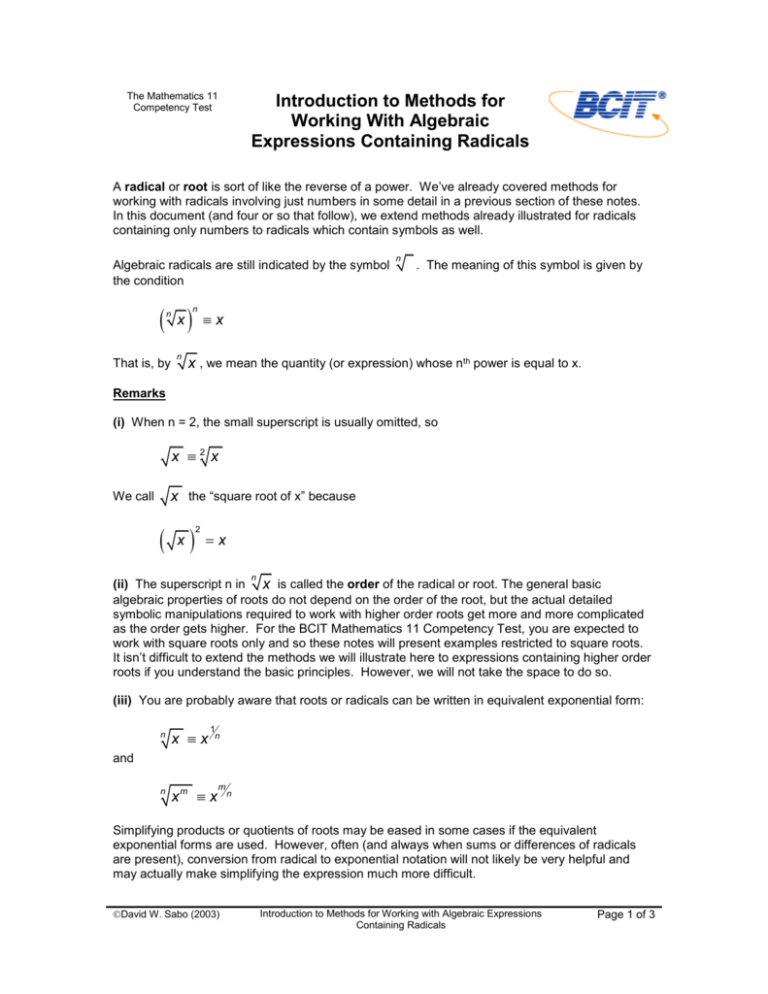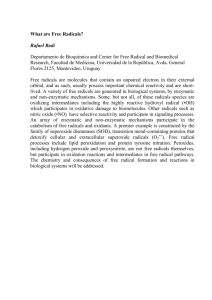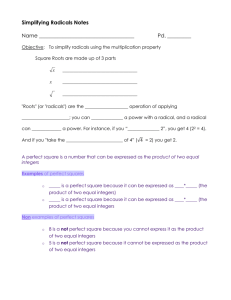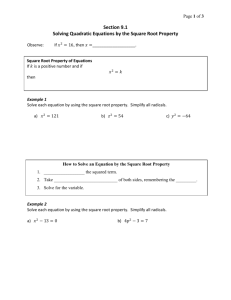The Mathematics 11 Competency Test
advertisement

The Mathematics 11 Competency Test Introduction to Methods for Working With Algebraic Expressions Containing Radicals A radical or root is sort of like the reverse of a power. We’ve already covered methods for working with radicals involving just numbers in some detail in a previous section of these notes. In this document (and four or so that follow), we extend methods already illustrated for radicals containing only numbers to radicals which contain symbols as well. Algebraic radicals are still indicated by the symbol the condition x n That is, by n n n . The meaning of this symbol is given by x x , we mean the quantity (or expression) whose nth power is equal to x. Remarks (i) When n = 2, the small superscript is usually omitted, so x 2 x x the “square root of x” because We call x 2 x n (ii) The superscript n in x is called the order of the radical or root. The general basic algebraic properties of roots do not depend on the order of the root, but the actual detailed symbolic manipulations required to work with higher order roots get more and more complicated as the order gets higher. For the BCIT Mathematics 11 Competency Test, you are expected to work with square roots only and so these notes will present examples restricted to square roots. It isn’t difficult to extend the methods we will illustrate here to expressions containing higher order roots if you understand the basic principles. However, we will not take the space to do so. (iii) You are probably aware that roots or radicals can be written in equivalent exponential form: 1 n n x x n xm x and m n Simplifying products or quotients of roots may be eased in some cases if the equivalent exponential forms are used. However, often (and always when sums or differences of radicals are present), conversion from radical to exponential notation will not likely be very helpful and may actually make simplifying the expression much more difficult. David W. Sabo (2003) Introduction to Methods for Working with Algebraic Expressions Containing Radicals Page 1 of 3 (iv) Radicals are closely related to the operation of multiplication. This means that there are some simple properties for multiplying or factoring radicals. Specifically x y n n n x n y n n xy x y and n xn x There are no simple rules for breaking up radicals of sums or for combining sums of radicals! We will emphasize this over and over again in the notes to follow, but to alert you to a very common error, we state here that you can never do something like n xy n x n y or n x n y n xy When written specifically for square roots, what we have just said is that y x y x x y and x 2 x y x but xy x y in general. Here, x and y represent any non-negative number or valid mathematical expression that will evaluate to a non-negative value in the case of square roots. (v) Radicals arise in technical applications because powers occur in technical applications. So, if you have squares of symbols appearing in formulas, solving problems based on such a formula will sometimes involve square roots. A very simple example is the following. The area, A, of a square whose sides have length s is given by A = s2 But then, if we know the area of the square and we need to compute the lengths of its sides, we must use the formula s A David W. Sabo (2003) Introduction to Methods for Working with Algebraic Expressions Containing Radicals Page 2 of 3 Why? Because if we need to square s to get the value of A, then s must be the quantity whose square is A – that is, s is the square root of A. David W. Sabo (2003) Introduction to Methods for Working with Algebraic Expressions Containing Radicals Page 3 of 3






